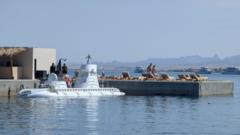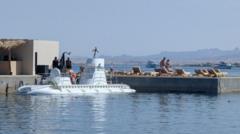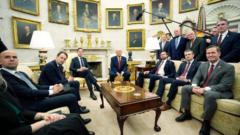Despite President Trump's claims of success, Pentagon assessments reveal limited achievements in Operation Rough Rider.
U.S. Military Campaign in Yemen Faces Challenges as Resources Deplete Rapidly

U.S. Military Campaign in Yemen Faces Challenges as Resources Deplete Rapidly
Over $200 million in munitions spent amidst meager progress against resilient Houthi forces.
In a span of only three weeks, the U.S. military has allocated an unprecedented $200 million in munitions for Operation Rough Rider, targeting Iranian-backed Houthi militants in Yemen. While President Trump lauded the campaign, asserting that the Houthis have been "decimated," internal Pentagon briefings present a starkly different scenario.
Military officials privately disclosed to Congressional aides that the operation, though intense, has seen limited effectiveness in dismantling the Houthis' extensive underground arsenal of missiles and drones. This disclosure contradicts the administration’s public narrative. The current campaign, characterized by a heavier bombardment compared to the previous Biden-era strikes, emphasizes the strategic urgency that the U.S. administration places on neutralizing threats posed by the militia.
Despite the significant expenditure and the deployment of high-value assets such as two aircraft carriers, B-2 bombers, and advanced missile defense systems like Patriot and THAAD, the Houthis continue to adapt and reinforce their operations. Congressional sources have indicated that the militants have cleverly fortified their sites, which hampers U.S. efforts to curb missile attacks targeting commercial shipping routes in the Red Sea.
The combination of substantial operational costs and the grudging realization of Houthi resilience raises critical questions about the long-term efficacy of U.S. military engagements in Yemen and the broader Middle East. As Congress receives these assessments, a growing sense of frustration and urgency may influence future U.S. military and diplomatic strategies in the region.
Military officials privately disclosed to Congressional aides that the operation, though intense, has seen limited effectiveness in dismantling the Houthis' extensive underground arsenal of missiles and drones. This disclosure contradicts the administration’s public narrative. The current campaign, characterized by a heavier bombardment compared to the previous Biden-era strikes, emphasizes the strategic urgency that the U.S. administration places on neutralizing threats posed by the militia.
Despite the significant expenditure and the deployment of high-value assets such as two aircraft carriers, B-2 bombers, and advanced missile defense systems like Patriot and THAAD, the Houthis continue to adapt and reinforce their operations. Congressional sources have indicated that the militants have cleverly fortified their sites, which hampers U.S. efforts to curb missile attacks targeting commercial shipping routes in the Red Sea.
The combination of substantial operational costs and the grudging realization of Houthi resilience raises critical questions about the long-term efficacy of U.S. military engagements in Yemen and the broader Middle East. As Congress receives these assessments, a growing sense of frustration and urgency may influence future U.S. military and diplomatic strategies in the region.




















